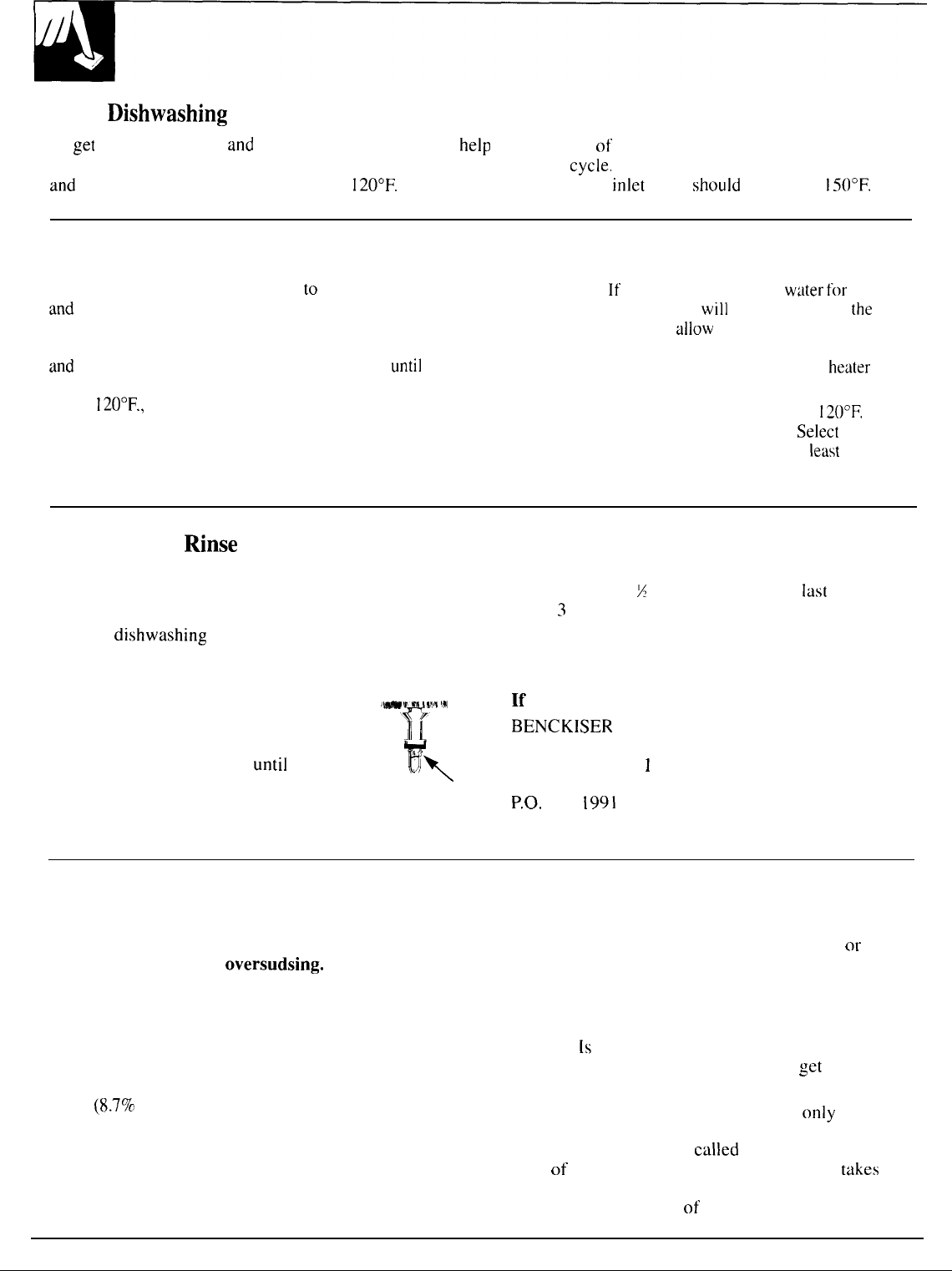
Good
Dishwashing
Starts with HOT Water
To
get
your dishes clean
and
dry, you need hot water. To
help
you get water of the proper
temperature, your dishwasher automatically heats the water in the wash
cycle.
For good washing
and
drying, the entering water must be at
120°F.
To prevent dish damage, the
inlet
water
should
not exceed
1500F.
How to Test Water Temperature
Higher water temperature is needed
to
dissolve grease
thermostat
up.
If
you have not used hot
water
for
some
and
activate powder detergents. Check water temperature
time, the water in the pipes
will
be cold. Turn on
the
hot
with a candy or meat thermometer. Turn on the hot water
water faucet at sink and
allow
it to run until water is hot.
faucet nearest dishwasher. Put the thermometer in a glass
Then start dishwasher. If you’ve recently done laundry
and
let the water run continuously into the glass
until
the
or run hot water for showers, give your water
heater
time
temperature stops rising. If the water temperature is
to recover before operating the dishwasher.
below
120°F.,
adjust your water heater.
To improve washability if water is less than
1200F.
Helpful hints:
If outside temperatures are unusually low,
and you cannot adjust your water heater:
Select
a
or if your water travels a long distance from water heater
longer cycle and fill both detergent cups at
Ietist
half-full
to dishwasher, you may need to set your water heater’s
with detergent.
How to Use a
Rinse
Agent
The rinse agent makes water flow off dishes quicker
than usual. This lessens water spotting and makes
drying faster, too.
For best
dishwashing
performance, use of a rinse
agent such as JET-DRY brand is recommended.
Rinse agents come in either liquid or solid form.
Your dishwasher uses the liquid form.
$-W
How
to fill rinse agent dispenser.
Unscrew
r
1811
IN
the cap. Note the Full line on the tip of the
cap. Add liquid rinse agent
until
it just
d
)1“
‘)<
reaches the top of the FULL line. Replace
FULL
the cap. The dispenser automatically
releases the rinse agent into the final rinse water.
How to Choose and Use the Right Detergent
First, use only powder or liquid detergent
specifically made for use in dishwashers.
Other types will cause
oversudsing.
Second, check the phosphate content. Phosphate
helps prevent hard-water materials from forming
spots or film on your dishes. If your water is hard
(7 grains or more), your detergent has to work
harder. Detergents with a higher phosphate level
will probably work better. If the phosphate content
is low
(8.7Y0
or less), you’ll have to use extra detergent
with hard water.
6
Your dishwasher’s rinse agent container holds
approximately 4
~
ounces. This should
last
about
3
months. Fill as needed. Do not overfill.
If you accidentally spill:
Wipe up the rinse
agent with a damp cloth. Don’t leave the spill in the
dishwasher. It can keep your detergent from working.
[f
you can’t find any rinse agent, write:
BENCKISER CONSUMER PRODUCTS, INC.
(“JET-DRY”)
Corporate Centre
1
55 Federal Road
P.O.
Box
i991
Danbury, CT. 06813-1991
Your water department can tell you how hard your
water is. So can your county extension agent
or
your
area’s water softener company. Just call and ask
them how many
“grains” of hardness there are
in your water.
How much detergent should you use? That
depends.
[s
your water “hard” or “soft’”? With
hard water, you need extra detergent to
get
dishes
clean. With soft water, you need less detergent.
Too much detergent with soft water not
only
wastes
money, it can be harmful. It can cause a permanent
cloudiness of glassware,
called
“etching.” An outside
layer
of glass is etched away! Of course, this takes
some time. But why take a chance when it’s easy
to find out the hardness
of
your water.


















